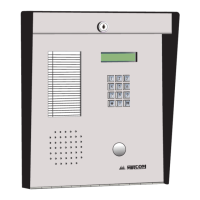DOOR
OVER-
RIDE
LOCK
BACK
D B D0 LB
DATA
NC C NO NC C NO
CLOCK
AUXILARY
RELAY
LATCH
COMON
ENTRANCE
ACTIVE
RELAY
ESTORE
ASTER
CODE
XICOR
X28C64P-25
ISSI
IS62 C256-70W
C24 20900SL
Mircom
SO-076
ADC-SD-120A
VER 3.01-D54S
JW4
JW5
JW6
MIC.
VOLUME
SPEA KER
VOLUME
PULSE
SENSITIVITY
ADJUST
S1 S2 M1 M212V T1 T2 T5 T3 T4 L1 L2 L3 L4 T6 T7 L5 L6
TO DISPLAY
+5V
G
-
TOSHIBA
TMP68HC11A0T
C11W
9730EBZ
JAPAN
PULSE
INDUCATOR
RESET,
ON/OFF
SWITCH
3
ON
OFF
MIRCOM TECHNOLOGIES LIMITED, ADC Series: Autodialer Telephone Access Systems Page 48
SYSTEM ADJUSTMENTS
CONTROL ADJUSTMENTS FOR ADC series CONTROLLERS (See FIG. 13)
1. MICROPHONE VOLUME : Adjust this control for the occupant's desired listening level. Turn clockwise to
increase volume.
2. SPEAKER VOLUME: Adjust this control for the desired speaker loudness at the Entry Panel. Turn clockwise
to increase volume.
3. PULSE SENSITIVITY ADJUST: Because of the condition of many of the older rotary "PULSE" type
telephones in use, there is great variation with the signal they generate to release the door. The control units
come factory preset to respond properly with these variations. If trouble is encountered in releasing the door
when using a rotary phone, this control may require adjustments as outlined below.
a) To increase sensitivity, turn the shaft of the control clockwise 1/10 of a revolution, then call the occupant
whose phone was previously not energizing the door release. Ask the party to dial "9" and observe if the door
release has been energized. Continue rotating the control 1/10 of a revolution at a time until the door release
is positively energized.
b) The control unit uses a crystal controlled electronic bandpass filter for the detection of the digit "9" for Touch
Tone type phones. Therefore no adjustments are required for tone type detection as long as the Resident
telephone can generate a "Touch-Tone" signal when on-line.
Figure 13: CONTROL LOCATIONS

